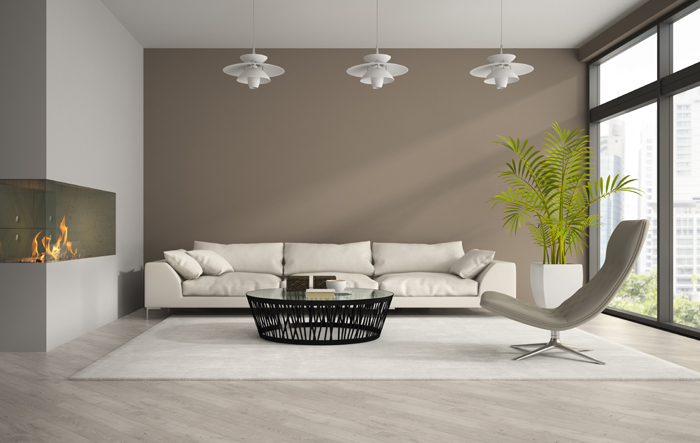Easy to love and easy to live with.
For decades, consumers seeking an alternative to natural wood, tile, and stone surfaces didn’t have a great many stylish choices. Vinyl and laminate products were, in the past, popular for their budget friendliness and ease of installation, but no one claimed they were as fashionable as real wood or tile.
Today, that has changed.
Luxury vinyl tile (LVT) and plank (LVP) have evolved into sophisticated products that high-end clients are choosing over wood and tile, because the new products look so similar to the natural surfaces they mimic. They perform extremely well and cost less.

Luxury Vinyl Flooring: How Faux became Fashionable.
Benefits of Luxury Vinyl
- Available in a fabulous assortment of designs, colors, and textures, resilient flooring brings you exciting new styles that create beautiful rooms.
- This type of floor is moisture resistant, impervious to most stains, and easy to clean.
- Resilient flooring doesn’t need to be waxed—its top layer is made to stay shiny.
- Heavy traffic is no problem, because these floors not only handle lots of activity, they’re actually resistant to scratches.
- Resilient flooring is … resilient. It’s flexible and comfortable underfoot, and there’s less breakage when items are dropped.
- The price tag is usually a very pleasant surprise.
In recent years, rapidly advancing high-tech processes have transformed LVT and resilient sheet flooring into products that look like the real thing. Such products are available in several price points, with the most expensive lines offering the most realistic look.
One significant change is that LVT and resilient sheet flooring no longer have to have the look of perfection that has long been the giveaway that the products were resilient. Higher-end LVT can effectively mimic distressed and antique floors, Foster says. With products designed to look like wood, longer planks placed irregularly give a look of authenticity, he says.
Today’s consumers are increasingly interested in Earth-friendly flooring. The new LVT and resilient sheet flooring products address these concerns by using virgin vinyl that doesn’t release harmful VOCs and adhesives that don’t have fumes. Some can be installed without any adhesive at all. Because the products are durable and have a timeless look, they’ll last for decades and not end up in a landfill as quickly.
Care & Maintenance of Vinyl
Please be sure to reference your resilient-vinyl floor warranty for specific care requirements! For your general information, however, here are some basic tips and facts:
- As needed, sweep your floor to remove dirt and grit.
- Wipe spills promptly.
- Mop occasionally using a special cleaner we can recommend-just ask your sales associate for guidance.
- Avoid using detergent or soap-based products, which will dim the shine.
- Most resilient-vinyl floors have finishes that do not require additional buffing, shining, or waxing-these actions, in fact, might harm the finish.
- Resilient-vinyl floors can be slippery when wet, so use caution when walking on them after mopping.
Installation Process
- Make sure you know who’s removing your existing flooring. If you wish, the installer will do it. If not, you should make arrangements to have it removed.
- Who’s moving the furniture? Decide in advance if you want to take on the responsibility or if you want the installer to handle it. Either way, be sure to remove all fragile items from the room.
- In general, your resilient-vinyl plank flooring should run parallel to windows or, in narrow rooms, to the longest wall.
- Measure door clearances before you have your resilient-vinyl installed. If the new floor is thicker than your existing floor, door bottoms may rub. Plan in advance to have someone shave or saw the correct amount off the bottom of each door so it does not drag.
- Paint first. If you’re planning to paint, wallpaper, or do any other remodeling in the room, it’s best to do it before your resilient-vinyl is installed. Keep extra paint to touch up any post-installation nicks.
To make your resilient-vinyl floor look good now and for a long time to come, proper installation is critical. Here’s the procedure an experienced installation professional will follow:
- Current flooring: A professional installer will start with a flat surface, which may require extensive prep work—such as removing the existing floor or installing a new subfloor on top of an existing floor. Sometimes, however, resilient-vinyl flooring can be installed directly on top of what you already have. Your installer will have the experience to know the best way to proceed.
- Moisture testing: Resilient-vinyl flooring is less sensitive to moisture than hardwood, but the existing subfloor will still need to be tested so that moisture-related problems can be avoided later. • Installation method: In floating floors, as the name suggests, planks are attached to each other, not to the subfloor. Glue-down floors require greater installation skill for the exacting process of adhesive application. As discussed below, room shape can also be problematic.
- Room shape: The configuration of a room can be a challenge, requiring precise measurement, cutting, and placement of flooring—another reason why proper installation by a professional will give you high-quality results.

It’s a good idea to check with us directly to find out if there are other actions we recommend before installation. Just call a member of our friendly sales staff.





